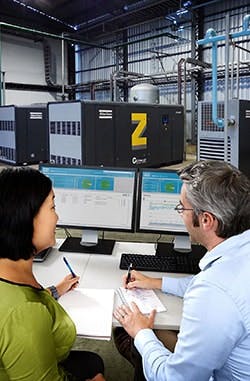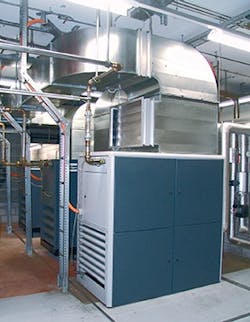Data Inflates Compressed Air System Performance
Substantial savings can result from proper understanding and managing of compressed air systems, as the experiences of Atlas Copco, Endress+Hauser Flowtec and Airleader demonstrate.
“Looking at air compressors as one tactical element of Industry 4.0 shows how connected devices can benefit your business and impact your bottom line,” says Paul Humphreys, vice president of communications and branding, Atlas Copco, Rock Hill, S.C. “There are five steps on this connected efficiency journey: auditing, design, optimization, service and monitoring.”
Every air compressor efficiency assessment should start with an audit, stresses Humphreys. This establishes the baseline and benchmark for calculating future savings. Devices have become more sophisticated, often smaller and nearly always with wireless connectivity, so access to data is much quicker than before. “The big industry change here is that auditing is moving to a continuous process,” he notes.
Designers no longer must rely on guesswork for configuring an air distribution system and a connected, efficient compressor room. Systems now available use augmented reality to measure compressor room or production floor area and calculate the amount of piping needed, and then to design the system in a way that reduces pressure drops and losses, Humphreys points out. “Using the latest CAD systems, the system design can be completed in perhaps 20% of the time it took ten years ago.”
Because energy consumption can account for up to 80% of the lifetime cost of a compressed air system, many companies now are turning away from operating one large compressor and instead opting for multiple, smaller compressors with a controller that runs them in sequence according to real-time changes in demand. “This advanced equipment can mean a larger initial investment but the savings on energy — often 40% or even more — provide a clear payback. Remember, an audit gives you a baseline to prove the value of investing in more-efficient technology,” Humphreys explains.
Centralized controllers provide another big advance in system optimization, Humphreys adds. “Think of them as the self-learning brains of a compressor room, ensuring that everything works in the best possible way. This advancement has led many customers to build a modular compressor room with smaller compressors. Centralized controllers link all compressors and dryers, lower the overall pressure band, eliminate the need for higher working pressure, and optimize the mix and combination continuously.”
Figure 1. Continuous tracking can make both auditing and optimization faster. Source: Atlas Copco.
Another aid to optimization comes from the intuitive functionality now available on compressors and controllers. Touch-and-swipe user interfaces are standard on many models. Some controllers feature built-in transmitting devices that allow wireless connectivity and monitoring, negating the need for two devices inside the compressor. Data displayed on controllers now appear as intuitive graphics for easier interpretation.
The Power Of Data
Servicing also has undergone radical change, with both compressor users and manufacturers having access to system data simultaneously in real time. Everyone can see the system’s history and the sequence of events that might have led to the issue. Technicians can connect into the compressor ahead of time, sort through potential culprits and be more proactive — resulting in shorter visits and reduced downtime.
“Perhaps the most important element is monitoring, relating as it does to that time-tested maxim: an ounce of prevention is worth a pound of cure,” Humphreys emphasizes.
The latest monitoring equipment for compressors can detect changes in heat and vibration as well as other issues, enabling corrective action — such as shutting down a compressor to forestall overheating — before a problem becomes more serious. Similarly, remote 24/7 monitoring now is widely available for compressed air systems. This has spurred manufacturers to set up remote monitoring centers, he says.
The remote technology also monitors energy usage, helping plants track, trace and optimize what they are doing (Figure 1). In the past, tracking such air demands only was possible by installing a data-logging unit on the compressor, letting it run for a week, taking it off, downloading and analyzing the data, and presenting the findings.
“This process, which could take several weeks, can now be completed in a few hours and, more importantly, can be constantly monitored — not just for short periods. Because these systems use cellular technology, there is no need to connect directly into the customer’s network. However, if a customer wants the data connected directly to their network to allay security concerns, that is easy to do,” he adds.
Plants value such monitoring and remote connectivity, and increasingly are looking for it in other products. So, to become even more competitive, manufacturers may work in one technology for products but across many different products — even ones they don’t manufacture — for connectivity, notes Humphreys.
“Will customers soon demand features in compressors that use advanced biometrics, such as fingerprint or iris recognition, to operate? Are voice-controlled compressors coming? That and much more will be possible — and successful manufacturers will have to chart that course as customer expectations demand. This much is clear: manufacturers must ensure that data help customers make better decisions, ensures their security and keeps them connected on their terms,” he concludes.
Reducing Inefficiencies
Endress+Hauser Flowtec, Reinach, Switzerland, notes that generation of compressed air by compressors consumes up to 10% of the electricity used by industry. As much as 95% is lost as unproductive waste heat in the process, while up to 30% of the compressed air generated “disappears” due to leakages in the supply network.
Company experience has shown that implementing appropriate measures can reduce this proportion by up to 10%, thus cutting power consumption. In large-scale systems, this quickly can save substantial amounts of money.
Nevertheless, plants continue to underestimate, ignore or simply accept as a given financial losses due to inefficient compressed air systems, says the firm.
“The digitalization of process information offers businesses many advantages, all of which promise to reduce operating costs while increasing operational efficiency. For these reasons, IOT [Internet of Things] has assumed a high level of priority within the company as a whole and among our individual technology fields,” explains Matthew Hull, expert product manager thermal mass.
Figure 2. Reliable and relevant process data can spur substantial savings in compressed air systems. Source: Endress+Hauser Flowtec.
For the company, this means investigating new avenues of information availability and giving devices additional capabilities — for example, flow meters that also can measure density, temperature, viscosity, conductivity and pressure.
At the same time, Hull is seeing more devices that can detect process disturbances or elements in the process that lead to a disturbed measurement. For instance, some instruments can spot water condensation in a compressed air system; such condensation could lead to measurement inaccuracies, depending on the technology, or even corrosion issues in the piping system.
“Of course, this increase in information about compressed air systems is advantageous for the user only when it can be made readily available. Therefore, at the same time, we are witnessing an increase in digital communication. The types of protocols are various and are heavily focusing on industrial ethernet standards. These systems not only enable the field devices to be connected to a programmed logic controller but also allow a connectivity between individual devices and networks. This provides the basis for IOT in an industrial setting,” he adds.
“The benefits of this high level of data availability and interconnectivity are clear. Data are the basis for any management system. Without the availability of data — and the relevant data, of course — it is impossible to execute decision-making at a reliable level,” Hull stresses.
In managing a compressed air system (Figure 2), certain parameters are extremely important for smooth and efficient delivery of compressed air, he points out. Ensuring the correct pressure, for example, typically requires measurements at multiple points within a compressed air network and usually always at the points of use. This way, a plant can confirm the pressure suffices for successful operation or take corrective measures if necessary. Monitoring of the compressed air’s quality, particularly its dewpoint, also is crucial to protect sensitive equipment or processes that the presence of water could harm.
Nevertheless, these process data only are useful if analyzed and evaluated by knowledgeable personnel. Proper evaluation of relevant data allows management to reach reliable decisions about improving the efficiency of compressed air systems, notes Hull.
“In the end, this translates into improved efficiency through better use of available tools, better scheduling of energy-intensive processes during low-tariff periods of the day, better degree of utilization through monitoring and adaptation of key parameters, less downtime through preventative maintenance and early detection of repair-needy parts. The bottom line is savings,” he says.
Building The Case
Many plants lack sufficient measurements, agrees Jan Hoetzel, principal of Airleader Compressor Management and owner and president of SIGA Compressed Air Solutions, both based in Grand Rapids, Mich. “We firmly believe that there is more of a need in measuring critical data points and creating key performance indicators. Compressor systems often account for a large portion of a company’s energy bill, yet often they are not given the attention deserved.”
Adequate data can play a crucial role in getting projects approved, he notes. For example, he cites an Airleader project that involved installation of a completely new compressor system. While the engineers and technical people understood the value of the work, the finance department struggled to see why the investment was worthwhile. “By having the measurements and being able to show the finance department that they were spending thousands of dollars a month on a faulty compressor system, they now had the reasoning to approve additional funding for the remodel,” Hoetzel explains.
Another challenge comes in the form of poorly designed compressed air systems with avoidable engineering errors, which largely arise because U.S. colleges and universities don’t teach about compressed air, he believes. With add-ons to existing compressed air systems, limitations related to know-how, space, current designs, budget and time frames often compromise performance. “Having visited a few large chemical plants, these errors don’t seem to be as common as [they are] for small and mid-sizes plants — which we often deal with,” he notes.
A compressed air audit will reveal all these issues and should include several main systems. It should detail the energy consumption of the compressor itself, pressure, differential pressure, dew point and flow. System layout and measurement of other parameters such as air quality and velocity can be important, too.
“With this information, a company can get a good idea of their baseline as well as any faults that may need fixing.” Addressing these faults often can provide a quick payback.
“Typically, during an improvement project, there is a pre- and a post-audit. What happens between is unknown. It is relatively expensive to install/uninstall and then re-install and uninstall audit equipment. Permanent monitoring just makes sense,” he counsels, adding that he’s seen a rise in the use of continuous monitoring of compressed air systems.
Sensors can generate a daunting amount of data, Hoetzel admits. So, he recommends connecting all sensors to a datalogger or monitoring system that can take the information from them and put it in one place. “Many sensors that are offered now have Modbus and Ethernet compatibility. Utilizing this would greatly benefit these companies.”
Seán Ottewell is Chemical Processing's Editor at Large. You can email him at [email protected].



